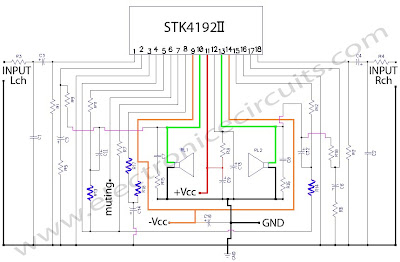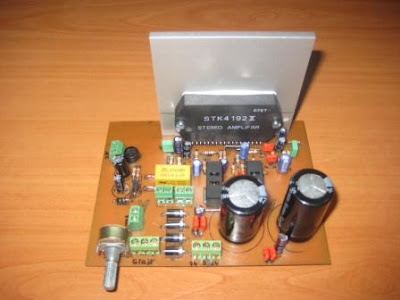STK 4192 Power Amplifier Circuit Features
- The STK4102II series (STK4192II) and STK4101V series (high-grade type) are pin-compatible in the output
- range of 6W to 50W and enable easy design. Small-sized package whose pin assignment is the same
- as that of the STK4101II series
- Built-in muting circuit to cut off various kinds of pop noise
- Greatly reduced heat sink due to substrate temperature 125°C guaranteed
- Excellent cost performance

Component List
R1___________ 56KΩ 1/4W Resistor
R2___________ 56KΩ 1/4W Resistor
R3___________ 1KΩ 1/4W Resistor
R4___________ 1KΩ 1/4W Resistor
R5___________ 560Ω 1/4W Resistor
R6___________ 560Ω 1/4W Resistor
R7___________ 100Ω 1/4W Resistor
R8___________ 100Ω 1/4W Resistor
R9___________ 56KΩ 1/4W Resistor
R10__________56KΩ 1/4W Resistor
R11__________3.3KΩ 1/4W Resistor
R12__________3.3KΩ 1/4W Resistor
R13__________3.3KΩ 1/2W Resistor
R14__________3.3KΩ 1/2W Resistor
R15__________4.7Ω 1/4W Resistor
R16__________4.7Ω 1/4W Resistor
R17__________1KΩ 1/2W Resistor
R18__________1KΩ 1/4W Resistor
C1___________ 400pF Polyester Capacitor
C2___________ 400pF Polyester Capacitor
C3___________ 2.2µF Polyester Capacitor
C4___________ 2.2µF 50V Electrolytic Capacitor
C5___________ 100µF 50V Electrolytic Capacitor
C6___________ 100µF 50V Electrolytic Capacitor
C7___________ 0.1µF 50V Electrolytic Capacitor
C8___________ 0.1µF 50V Electrolytic Capacitor
C9___________ 10µF 50V Electrolytic Capacitor
C10___________ 10µF 50V Electrolytic Capacitor
C11___________ 47µF 50V Electrolytic Capacitor
C12___________ 47µF 50V Electrolytic Capacitor
C13___________ 100µF 50V Electrolytic Capacitor
C14___________ 10µF 50V Electrolytic Capacitor
IC___________ STK4192II Integrated STK Power Amplifier series
R1___________ 56KΩ 1/4W Resistor
R2___________ 56KΩ 1/4W Resistor
R3___________ 1KΩ 1/4W Resistor
R4___________ 1KΩ 1/4W Resistor
R5___________ 560Ω 1/4W Resistor
R6___________ 560Ω 1/4W Resistor
R7___________ 100Ω 1/4W Resistor
R8___________ 100Ω 1/4W Resistor
R9___________ 56KΩ 1/4W Resistor
R10__________56KΩ 1/4W Resistor
R11__________3.3KΩ 1/4W Resistor
R12__________3.3KΩ 1/4W Resistor
R13__________3.3KΩ 1/2W Resistor
R14__________3.3KΩ 1/2W Resistor
R15__________4.7Ω 1/4W Resistor
R16__________4.7Ω 1/4W Resistor
R17__________1KΩ 1/2W Resistor
R18__________1KΩ 1/4W Resistor
C1___________ 400pF Polyester Capacitor
C2___________ 400pF Polyester Capacitor
C3___________ 2.2µF Polyester Capacitor
C4___________ 2.2µF 50V Electrolytic Capacitor
C5___________ 100µF 50V Electrolytic Capacitor
C6___________ 100µF 50V Electrolytic Capacitor
C7___________ 0.1µF 50V Electrolytic Capacitor
C8___________ 0.1µF 50V Electrolytic Capacitor
C9___________ 10µF 50V Electrolytic Capacitor
C10___________ 10µF 50V Electrolytic Capacitor
C11___________ 47µF 50V Electrolytic Capacitor
C12___________ 47µF 50V Electrolytic Capacitor
C13___________ 100µF 50V Electrolytic Capacitor
C14___________ 10µF 50V Electrolytic Capacitor
IC___________ STK4192II Integrated STK Power Amplifier series
power sapply recommend for the STK 4192
Tips that bass sound more felt
according to experience, you have to do a little experiment for you to get the best bass sound, stalwart, gigantic. To get the best bass sound between the subwoofer and the room you, then you should get a 'pass that point. the following manner:
- Place the subwoofer on your location on our seat. (sub Woofer do not be put on the table / cupboard you high more than 1 / 2 meter)
- Turn the sub Woofer and you do not forget to disconnect the speaker Amplifier.
- Play a song you like, which have gained a good frequency bass
- Then try running memutari room, see the characters that appear bass.
- You will hear some of the bass sound quality improvements in some corner of the room. This happens due to the interaction between low-frequency space and you. Nah corners you can select as a "node" or the point pas you need to immediately place your subwoofer in a corner of it.









